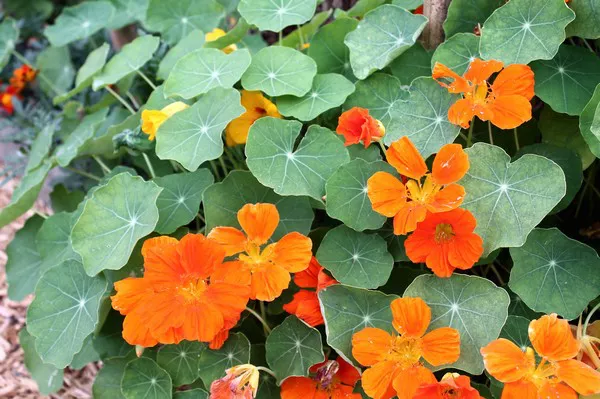Edible flowers have been gracing culinary creations for centuries, adding a touch of elegance, vibrant colors, and unique flavors to dishes. While not all flowers are safe to eat, many varieties are not only edible but also boast delightful tastes that can elevate your culinary adventures. In this extensive guide, we will explore the top 13 edible flowers, celebrating their diverse uses in the kitchen and the delightful experiences they offer to the discerning palate.
13 Best Edible Flowers
1. Nasturtium (Tropaeolum majus)
Nasturtiums are not only visually stunning with their bright, jewel-toned petals but also offer a peppery and slightly spicy flavor. Both the leaves and flowers are edible, making them versatile additions to salads, sandwiches, or as a garnish for various dishes. Nasturtiums thrive in gardens or containers and are known for their easy cultivation, making them a popular choice for both novice and seasoned gardeners.
2. Viola (Viola spp.)
Violas, often known as pansies, boast delicate petals with a mild, slightly sweet flavor. These flowers come in an array of colors, making them a delightful addition to salads, desserts, and cocktails. Violas are also suitable for candying and can be used to decorate cakes or pastries. Ensure that you source violas specifically labeled as edible, as some ornamental varieties may be treated with pesticides that are not safe for consumption.
3. Calendula (Calendula officinalis)
Calendula, commonly known as marigold, offers sunny, golden petals with a subtly peppery taste. These edible flowers can be used to infuse oils, create vibrant salads, or add a pop of color to soups and stews. Calendula petals are rich in antioxidants and have been historically used for their potential health benefits. Ensure you harvest calendula flowers that are free from pesticides or other chemicals for culinary use.
4. Lavender (Lavandula spp.)
Lavender, with its fragrant and aromatic blossoms, is a versatile edible flower. The flowers impart a floral and slightly sweet flavor, making them suitable for both sweet and savory dishes. Lavender-infused syrups, desserts, or even lavender-infused salts can showcase the unique taste of these blooms. Ensure you use culinary lavender varieties, such as Lavandula angustifolia, to avoid any bitterness that may be present in other lavender species.
5. Rose (Rosa spp.)
Roses are not only symbols of love but also delightful additions to the culinary world. The petals of certain rose varieties offer a subtle floral taste that can be used in a variety of culinary applications. Create rose petal jams, syrups, or add them to salads for an elegant touch. Ensure that the roses you use are unsprayed and specifically designated as edible, as some commercial varieties may be treated with chemicals.
6. Chive Blossoms (Allium schoenoprasum)
Chive blossoms, the flowering tops of chives, bring a mild onion flavor to the table. These edible flowers are not only delicious but also visually appealing with their lavender-hued blossoms. Chive blossoms can be used in salads, as a garnish for soups, or infused into vinegars for added flavor. Harvest the blossoms just as they open for the best taste, and remember to snip them above the green stem.
7. Pansy (Viola tricolor var. hortensis)
Pansies, belonging to the Viola family, offer delicate petals with a mild, grassy flavor. These flowers are often used to garnish salads, desserts, or cold drinks. Pansies are suitable for crystallizing and can be used to create stunning cake decorations or confectionery. When using pansies, choose varieties labeled as edible, and ensure they are free from pesticides or other chemical treatments.
8. Dandelion (Taraxacum officinale)
Dandelions, often considered garden nuisances, are entirely edible, from their roots to their flowers. The bright yellow petals have a slightly sweet flavor, and they can be used in salads, jellies, or infused into beverages. Dandelion flowers are rich in antioxidants and can be a unique addition to your culinary repertoire. Ensure you source dandelions from pesticide-free areas, preferably your own organic garden.
9. Borage (Borago officinalis)
Borage, with its vibrant blue flowers, has a mild cucumber-like flavor. These edible flowers are not only visually striking but can be used in salads, cold soups, or frozen into ice cubes for refreshing drinks. Borage flowers are also rich in essential fatty acids, adding a nutritional boost to your culinary creations. Ensure you harvest borage flowers when they are fully open for the best flavor.
10. Bee Balm (Monarda didyma)
Bee balm, also known as bergamot or Oswego tea, offers striking red blossoms with a distinctive citrus flavor. These edible flowers can be used to infuse teas, create floral syrups, or garnish summer salads. Bee balm is a favorite among pollinators, adding ecological value to your garden while also providing a unique culinary experience. Harvest bee balm flowers just as they begin to open for optimal flavor.
11. Elderflower (Sambucus nigra)
Elderflowers, the creamy white blossoms of the elderberry plant, have a delicate floral taste with subtle hints of honey. These edible flowers are popular for making elderflower cordials, syrups, or even fritters. Elderflowers can add a sophisticated touch to desserts, cocktails, or drizzled over fresh fruit. Ensure you harvest elderflowers in the morning when their fragrance is most potent.
12. Tulip (Tulipa spp.)
Tulips, often associated with springtime beauty, are surprisingly edible. The petals have a crisp texture and a mildly sweet flavor, making them suitable for salads, desserts, or as a unique garnish. When using tulips in culinary applications, opt for fresh, organically grown varieties. Remember that only the petals are edible, and remove the stamens and pistils before consumption.
13. Squash Blossoms (Cucurbita spp.)
Squash blossoms, the delicate flowers of various squash and zucchini plants, are not only beautiful but also delicious. These edible flowers have a subtle squash flavor and can be stuffed, battered, and fried for a delightful appetizer. Use squash blossoms in omelets, salads, or as a topping for pizzas. Harvest male blossoms for culinary use, leaving female blossoms to develop into fruits.
See Also: Top 10 Flowers For Valentine’s Day Celebration
In conclusion, the world of edible flowers opens up a realm of culinary possibilities, allowing chefs and home cooks alike to experiment with flavors, colors, and textures. From the peppery kick of nasturtiums to the sweet aroma of roses, each edible flower on this list brings its unique essence to the dining table. As you embark on your culinary journey, remember to source flowers from organic, pesticide-free sources, and always exercise caution when trying new varieties. Whether you’re creating edible flower salads, infusing beverages, or crafting stunning desserts, these flowers are sure to add a touch of floral sophistication to your gastronomic endeavors.
You Might Be Interested In:


























